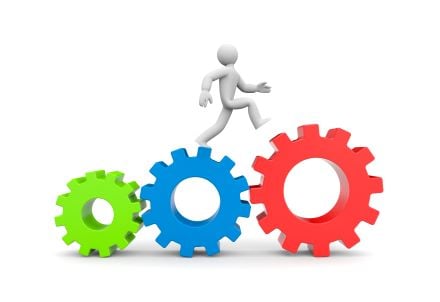Methods Perceptual Style and Teamwork
(Please click on the picture above to see a three minute presentation on the Methods Perceptual Style)
.jpg)
Jack’s Perceptual Style™ is METHODS.
Jack perceives the world in a rational, matter-of-fact manner. He sees a world that is sensible, logical, and factual. Things are what they are.
He believes that the facts, when properly presented, will speak for themselves.
Jack uses a rational application of facts to make decisions and solve problems, and he’s confident that he will arrive at the correct conclusion through this method.
Jack strives to be objective and fair, to act as an expert who understands and presents the facts and logic of a situation.
He knows there’s a correct approach by which each problem, undertaking, or objective can be best handled. Acting any other way just makes things harder than they need to be. Jack enjoys discovering and applying the correct approach; the satisfaction lies in identifying the steps and planning the correct sequence.
When it comes to teamwork, Jack is a reliable and stable member of any team. He sees the benefit of collaboration especially when team members contribute as much value as they receive. Jack is comfortable functioning independently and also enjoys the camaraderie of teamwork.
Create Amazing Teams
You always know a great team when you see one. Their accomplishments are a combination of each team member's individual talents and a shared commitment to the team’s success.
Great teams are comprised of diverse people who learn to trust each other, respect each other's strengths, and support each other to fill in the gaps. They build a camaraderie that includes mutual support and accountability.
There’s no better foundation for building a great team than understanding each team member's strengths and the way they take action in the world. Our Team Dynamics Blueprint helps your team harness the power of Perceptual Style™ to create greater understanding, communication, and collaboration.
Together you will define the exact skills your team needs to succeed in your mission and you will discover:
-
The composite strengths of your team – where each team member excels, where they have hidden potential, and where there may be challenges.
-
How to match team members to tasks that maximize their natural strengths and how to mitigate skill gaps.
-
Techniques to strengthen team communications.
-
How to create a team culture that honors each individual and creates team commitment and accountability.
The Methods Perceptual Style is the foundation of great teamwork
Three of the most important aspects of successful teamwork are directly impacted by the Perceptual Styles of the team members – skill strengths, communications, and capacity for action.
-
Perceptual Style is the basis of your natural skills – the way you see the world and take action influences the skills that are naturally easy for you to master.
-
Your communication skills are influenced by your Perceptual Style – the words you choose when you speak, how you listen, and what you write.
-
Perceptual Style also influences the way you make decisions and take action.
Great teamwork starts with understanding the strengths of each Perceptual Style, because teams are made up of people with different Perceptual Styles.
It’s a fact. People truly do perceive the world differently, and this differing perception leads to different conclusions about what is important, how things should be done, and what is the “truth” of any situation.
Perceptual Style Theory™, created by Gary M. Jordan, PhD, and Lynda-Ross Vega, defines six unique Perceptual Styles.
Perceptual Style represents a unique grouping of fundamental aspects of being human that results in a distinctive experience and characteristic behaviors.
Have you met all of our Perceptual Style representatives? Press the blue tabs below to read about each specific Perceptual Style.
The people above represent each Perceptual Style—Tina is Activity, Pam is Adjustments, Matt is Flow, Anne is Goals, Jack is Methods, and Dan is Vision. Who did you identify with most?
Not Sure? you like to get a taste of what your Perceptual Style and a few of your strengths may be?
We’ve created an introductory sample assessment just for YOU!
The more you know about your Perceptual Style, the more you can tap into your natural strengths and potential. That’s because there’s an extensive set of skills and behaviors that naturally align with each Perceptual Style.
The alignment of skills and behaviors with Perceptual Style exists because people naturally see the things associated with their Perceptual Style. Those things are easy for them to grasp, understand, and use.
Awareness of the other five Perceptual Styles and how they differ from you provides incredible insights about your relationships with family and friends.
Each of the six Perceptual Styles approaches the challenge of teamwork differently. Understanding how to blend these differences can be the difference between success or failure within a team.
Here are some examples of how each Perceptual Style approaches Teamwork:
ACTIVITY
-
You are an energetic member of any group and are effective at generating enthusiasm and initiating action.
-
You intuitively focus on the team process. You shift topics or tasks and interject humor to revitalize a team when progress is slow or stuck in the details.
-
Because you enjoy being with others, whether for work or play, you tend to think in terms of "We" rather than "I".
-
Your excitement infuses others with energy, and you suggest new ways to approach routine tasks or problems that result in creative alternatives.
ADJUSTMENTS
-
You are an effective and productive team member. You are content to focus on your assignments and do so thoroughly and with quiet efficiency.
-
You easily assume a mediator role, using your objective observation and natural impartiality to help choose solutions to problems.
-
You provide others with access to whatever sources of knowledge will improve their value to the team.
-
With your natural sense of diplomacy, you skillfully work through issues between group members to enhance cooperation.
FLOW
-
You use your affinity for collaboration as the foundation for your Teamwork. You know working together always prodcues better results than working alone.
-
You read the interactions between people, constantly checking for and mitigating barriers that inhibit group progress.
-
You facilitate a group’s well-being by subtly ensuring that each person has a stake in the team’s existence and it's success.
-
You assure that decisions, actions, and accomplishments reflect the team as a whole rather than any one individual member.
GOALS
-
You value your independence and enter into collaboration when there is a specific purpose and benefit.
-
You are unlikely to join teams as “just one of the members” as you quickly insert your opinion and look for opportunities to lead.
-
You are skilled at identifying who brings the necessary talents to achieve a specific plan, and you recruit them to join you.
-
You organize teams for specific functions and quickly disband the teams when your objectives have been met.
METHODS
-
You see the benefit of teamwork when everyone contributes skills of equal value and plays by the same rules.
-
You are comfortable functioning independently, and while you enjoy the camaraderie of teamwork, you don’t seek it out.
-
You avoid personal and emotional entanglements. You work dependably and cooperatively with other team members as long as they are focused on achievement.
-
You are at your best in collaborations with a logical plan designed to produce specific, concrete, measurable results.
VISION
-
You are a dynamic collaborator who energizes and catalyzes people into action.
-
You communicate a sense of urgency and model a vitality that makes things happen.
-
You are quick to recognize the abilities and potential in others and are adept at finding activities for them that take advantage of their talents.
-
You do not build or maintain collaboration solely for the sake of working with others; instead, you see collaboration as a resource to be used strategically to accomplish your agenda.
Understanding how each Perceptual Style approaches Teamwork allows team members to rely on each other’s strengths, focus on what needs to be done, and mitigates communication disconnects.
The Team Dynamics Blueprint

Our Team Dynamics Blueprint helps your team harness the power of Perceptual Style to create greater understanding, communication, and collaboration with each other. We combine the power of two of our assessments - the Perceptual Style Assessment™ and Recognized Strengths Profile™ - with individual results sessions and a team workshop to create a one-of-a-kind team building experience.
Together you'll discover:
-
The differences in the way you each see the world and the natural strengths you each bring to the team.
-
The ways you each prefer to interact with others and what this means to your team.
-
The composite strengths of all team members and the roles each will shine in.
-
Any gaps in roles needed by the team that aren't supported by team member strengths and how to close those gaps.
-
Individual communication strengths and challenges with tips on how to maximize connection and avoid disconnects.
-
Each team member's hidden potential and how to bring it out in team activities.
-
How you each handle conflict and tips on what to do to help resolve it when it happens.
-
How you each approach change and tips on how to support each other.
Imagine the success your team will achieve with effective communication,
team members matched to tasks at hand based on their strengths,
and team commitment to success.
The Team Dynamics Blueprint is the foundation for your team's success!
Pricing for this amazing program begins at $1295 for a team of five (add $97 for each additional team member to be included). Just look at what's included:
-
The Perceptual Style Assessment and the Recognized Strengths Profile assessment for each team member.
-
Personalized Celebrate You and Recognized Strengths Profile action guides for each team member.
-
One-on-one assessment results review sessions for each team member with a certified Perceptual Style guide.
-
A 1-day interactive workshop for the entire team led by Lynda-Ross and Gary (approximately 7 hours in length and presented in person or as a live webinar).
-
A customized Team Dynamics Blueprint report.










